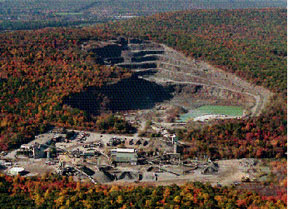Rocks Build America
Aggregates are some of the most important rocks and minerals we use. Generally, they are also the least glamorous and appealing to the eye. If you are not already familiar with the term aggregate, think of it in terms of sand, gravel and crushed stone.
Sand and gravel was produced from about 6,600 active operations in the 50 States. The estimated output for was 911 million tons in 2014, valued at more than $7 billion. In the same year, an estimated 1.26 billion metric tons of crushed stone were produced in the United States from about 4,100 active surface quarries and underground mines with an estimated value of more than $12.8 billion.
Aggregates are a major basic raw material used in construction. Imagine our lives without roads, bridges, streets, bricks, concrete, wallboard and roofing tiles or without paint, glass, plastics and medicine. Every small town or big city and every road connecting them were built and are maintained with aggregates.
Infrastructure (such things as roads, airports, utilities and many other facilities) is vital to the growth of any populated area. Much of the infrastructure in the US was built during the 1950's and 1960's and has begun to deteriorate. In many areas of rapid population growth, the infrastructure is becoming inadequate, and new roads, streets and sewage systems must be built to meet the increased needs.
More than 90 percent of asphalt pavements and 80 percent of concrete are aggregates. The production of recycled aggregates, mostly from concrete and asphalt pavements, has been increasing in recent years. Replaced and reconstructed old roads and buildings have become major sources of "recyclable materials." In some applications, recycled aggregate can compete with newly mined aggregates on price and quality.
Limestone is one of the most common minerals used as aggregate. But when ground into powder, it becomes an important mineral supplement in livestock feed. We also use the calcium carbonate found in limestone in anti-acid products such as Tums, Rolaids, Pepto Bismal etc. as well as in other common household products.
Limestone is also used in "scrubbers" which are attached to tall "smoke" stacks at electric power generation plants to help reduce the amount of sulfur dioxide emitted into the atmosphere where it contributes to acid rain problems.
Aggregates are also used to protect our health and environment. Most water purification plants use some form of aggregate in the filtering process so that when you turn on the tap for a cool glass of drinking water, it will be clean, clear and free of harmful bacteria and chemicals.
Of the crushed stone produced in the United States:
- limestone and dolomite account for 71%
- granite - 15%
- gabbro, basalt and diabase (also known as traprock) - 8%
The remaining 6% of the crushed stone produced is: sandstone, quartzite, marble, calcareous marble, slate, shell, volcanic cinder and scoria.
The production of natural aggregates is closely related to the population and the level of industrial development of a specific area. On an annual basis every person in the U.S. requires at least:
- 6.32 tons of crushed stone (12,464 lbs.)
- 4.86 tons of sand and gravel (9,718 lbs.)
- 1/2 ton of cement (965 lbs)
Other interesting facts:
- During the past 60 years, per capita consumption of aggregates has increased from 3.5 tons per year to over 10 metric tons annually - that is just over 22,000 lbs. for every man, woman, and child in America each year.
- Production of aggregates in the U.S. went from about 351 million metric tons in 1940 to nearly 3 billion metric tons in 2005 valued to 17.4 billion.
- Every state, virtually every Congressional District and 70% of the nation's counties are home to an aggregate operation.
- And estimated 38,000 tons of aggregates are necessary to construct one mile of lane of interstate highway.
- Constuction of an average modern home requires 400 tons of aggregate.
- Construction of an average size school or hospital requires 15,000 tons of aggregates.
- Aggregates make up 94% of asphalt and 80% of concrete.
- Within 50 miles of their place of extraction is where 90% of aggregates are used.
EVERYTHING WE USE MUST START WITH RAW MATERIALS THAT ARE GROWN OR MINED.
So even though we recognize that Earth's resources - however vast - are finite, we must also realize that in order to maintain or improve our standard of living, we MUST be able to locate and use mineral resources. We also understand that wise stewardship of the environment is necessary to preserve natural resources for future generations.
Conservation and land reclamation have become a mandatory consideration in the mining of aggregates. In todays real world, companies must meet the requirements of thousands of environmental regulatory requirements at several levels of government.
The results of successful reclamation projects can be seen around the country where housing subdivisions, shopping malls, community parks and lakes, golf courses and wildlife refuges are now present on what was once an aggregate producing area.
Just because aggregate materials are widely distributed throughout the United States and occur in a variety of geologic environments does not necessarily mean they are universally available. Some areas lack quality aggregates, or existing aggregates deposits cannot be mined for a multitude of reasons.
Economic factors require that pits or quarries be located near population centers. However, many residential communities now commonly require that mining of aggregates be conducted far from their boundaries. Thus, competing land-use plans, zoning requirements and various regulations frequently prohibit extraction of aggregates near the populated areas where they will be used.
The demand for aggregates will continue to grow in the future. Provisions to assure adequate supplies will have to be made. Long-range planning and zoning regulations will have to take into account current and future community needs for this valuable natural resource. All groups and individuals will need to work together to ensure adequate community and environmental protection, while ensuring the availability of aggregates at a reasonable cost that will allow growth and prosperity.



